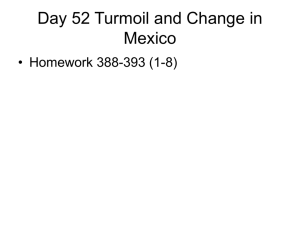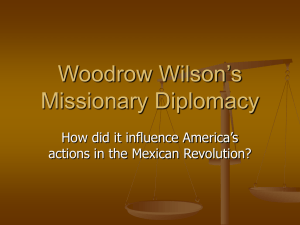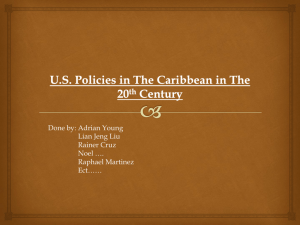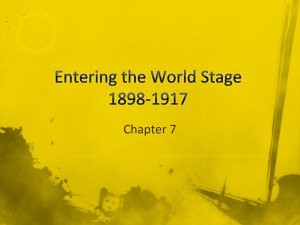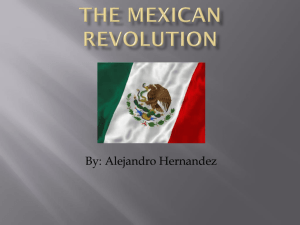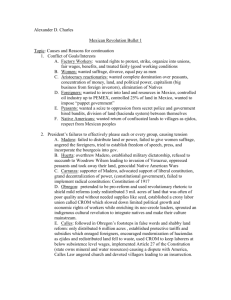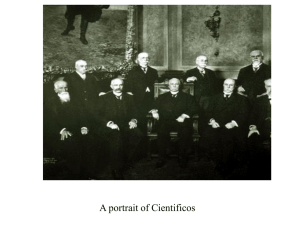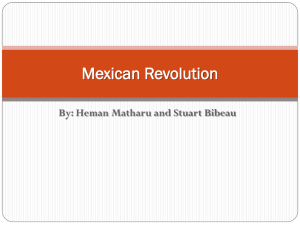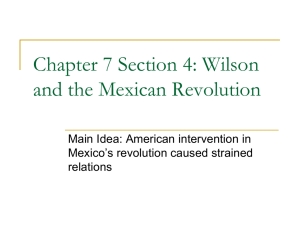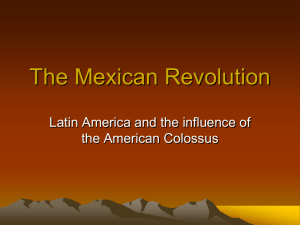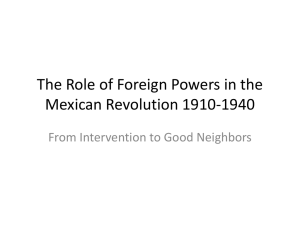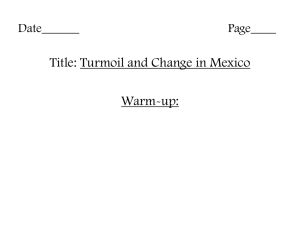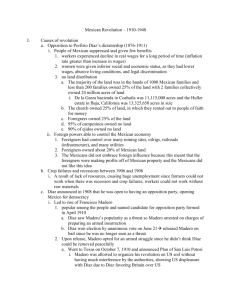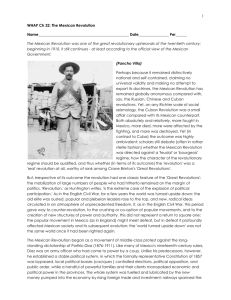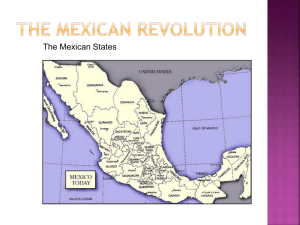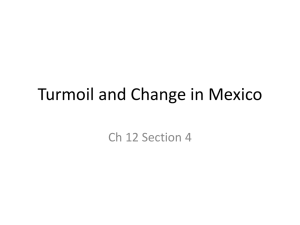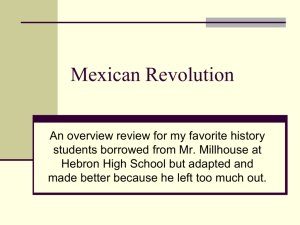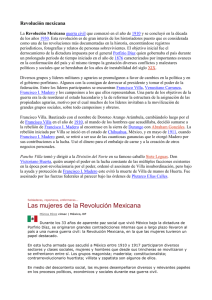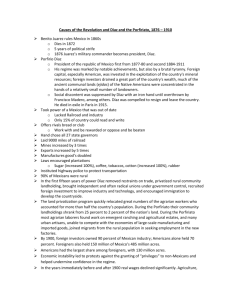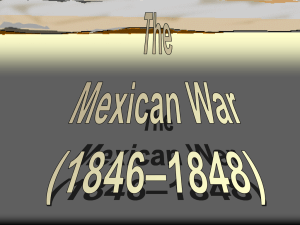The Mexican Revolution
advertisement
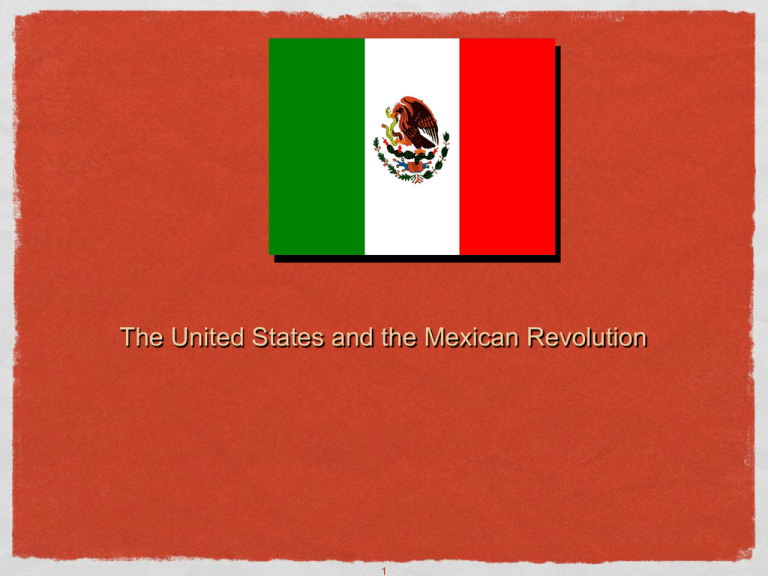
The United States and the Mexican Revolution 1 The Mexican Revolution David Siquieros Mural: “Poeple in Arms” Mexico Under Porfirio Diaz Diaz became President in 1877, and imposed order by suppressing opposition. He attracted foreign investors, especially the United States By 1908 the United States controlled ¾ of Mexican mining By 1913 more than ½ of Mexico’s $2 Billion in foreign investments came from the United States 3 Los Rurales Porfirio Díaz (1830-1915) David Siquieros Mural: "Don Porfirio [Diaz] and his Courtesans". 1957-65 A Mural by Diego Rivera The Decadence of the Porfiriato The seeds of revolution Diaz’s policies were not popular with all Mexicans, especially the workers and the poor Emiliano Zapata wanted land for the American Indian peasant population Diaz resigned in May of 1911 after rebel troops were victorious in northern and central Mexican cities 6 Francisco Madero Madero entered Mexico City to triumphal acclaim in early June 1911. Madero and the Revolutionary Leadership, 1911 Emiliano Zapata and the Revolution in Morelos David Siquieros‘ “Zapata on Horseback” Emiliano Zapata (1879-1919) Zapatistas moving to take cornfields. Fransisco Madero Madero was elected President in 1911 The United States supported Madero’s attempt to create a democratic government by placing an embargo on arms sales to his opponents February 1913 = rebels, led by his own military chiefs, attack Madero’s forces to gain control of Mexico Victoriano Huerta, Madero’s commanding general, took control of the country Madero was imprisoned and killed while supposedly trying to escape 14 General Bernardo Reyes Félix Díaz General Vitoriano Huerta Henry Lane Wilson Madero fell to a military coup in February of Fraincisco Madero 1913 Huerta’s Mexico Most European governments recognized Huerta as the new leader of Mexico The United States did NOT recognize Huerta because of how he had come to power. President Wilson began his “watchful waiting” for a chance to take Huerta out of power Huerta also faced opposition from 4 rebel armies led by Venustiano Carranza, Fransisco ‘Pancho’ Villa, Emiliano Zapata, and Alvaro Obregon 16 General Victoriano Huerta The Dolphin Incident the US ship was stationed near Tampico, a town controlled by Huerta. Several crew members were arrested by Huerta loyalists when they went ashore. They were released, and an apology was offered by the arresting soldiers’ superiors BUT the United States demanded a formal apology and a 21 gun salute to the American flag April 22-Congress gave Wilson permission to use armed forces against Mexico 18 United States Intervention Wilson got his opportunity to act quickly The United States seized the port city of Veracruz because they had learned a German ship was landing there with arms for Huerta 19 marines and over 300 Mexican civilians were killed during the capture of the city. Huerta’s troops had already left the city 19 April 1914: President Wilson sends U.S. troops to occupy Veracruz U.S. troop ship Monuments to the Defenders of Veracruz against U.S. troops Other countries intervene Argentina, Brazil, and Chile– the ABC powers convened a conference about the crisis in Mexico They called for Huerta’s resignation and the creation of a provisional government Huerta refused until July 1914 when he resigned and fled to Spain 22 The End of the Revolution In March 1915 Venustiano Carranza became the provisional president of Mexico after he reentered Mexico City. The United States recognized his government six months later 2/3 of Mexico was still under the control of rebel leaders Emiliano Zapata and Pancho Villa until April 1915 when Villa was defeated 23 Villa and Zapata in Mexico City November, 1914 Villa’s Troops Enter Chihuahua, 1914 The First Chief: Carranza Venustiano Carranza (1859-1920) “Plan of Guadalupe” Venutiano Carranza and Alvaro Obregón Alvaro Obregón (1880-1923) Pancho Villa Villa was upset the United States had recognized Carranza’s government because he believed the United States should not have interfered in Mexican politics Villa raided a small New Mexican town-- 17 Americans and over 100 of Villa’s men were killed Wilson sent General John J. Pershing to Mexico to capture Villa “dead or alive” 30 Pancho Villa and His Supporters The Pursuit of Pancho Villa 15,000 US troops tried to capture Villa in his home state, but they were unsuccessful Pershing’s troops battled Mexican soldiers when the US troops entered the city of Carrizal instead of going around it When Wilson realized a war between the 150,000 US troops on Mexico’s border and the Mexicans was imminent, Wilson ordered the troops to withdraw in January 1917 32 Pancho Villa 1880-1923 Venustiano Carranza in Power Carranza called for a Constitutional Convention in December 1916 Villa was still in hiding and Zapata’s only stronghold was in the South A new constitution was ratified in February 1917 The constitution put the common welfare above that of individual rights; protected workers with an 8 hour day, the right to establish unions, and collectively bargain; and established national ownership of most of 34 Between 1910 and 1920, between 1.5 and 2 million Mexican lost their lives in the Revolution. The census takers in 1920 counted almost a million fewer Mexican than they had found only a decade before. Las Soldaderas Las Soldaderas Rivera’s “Good Government”
